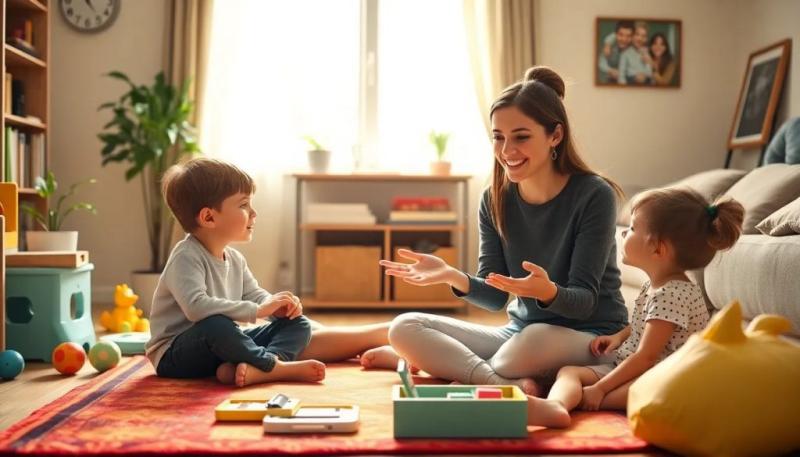Conflict resolution skills are essential for babysitters to maintain a harmonious environment for children. Understanding how babysitters manage conflict resolution aids in creating a peaceful atmosphere, minimizing disputes, and ensuring that both children and caregivers feel secure.
By employing effective communication techniques and problem-solving strategies, babysitters can address conflicts proactively, fostering positive relationships with both children and parents.
Managing conflict in the babysitting environment
Conflicts can arise unexpectedly in babysitting situations, often due to differing expectations between babysitters and parents or children. Managing conflict in the babysitting environment requires a heightened awareness of the dynamics at play.
One important aspect is recognizing the triggers of conflict, which can include miscommunication, unmet needs, or behavioral issues from children. When babysitters are aware of these triggers, they can take steps to prevent them.
- Establishing clear guidelines and expectations.
- Encouraging open communication with parents.
- Providing a safe space for children to express their feelings.
By implementing these strategies, babysitters can effectively manage conflicts and create a positive environment for the children under their care.
Understanding the sources of conflict in babysitting
To effectively address conflicts, babysitters must understand where these conflicts originate. Common sources include differing parenting styles, expectations about discipline, and misunderstandings about the babysitter's role.
For instance, a babysitter may be instructed to enforce certain rules, but if those rules conflict with the child’s usual routine, it can lead to resistance or outbursts. Identifying these potential conflicts beforehand allows babysitters to adapt their approach.
- Differences in parenting styles.
- Unclear expectations regarding responsibilities.
- Children's emotional responses to changes.
By recognizing these sources of conflict, babysitters can prepare to handle situations more effectively, fostering a smoother caregiving experience.
Effective communication techniques for babysitters
Effective communication is crucial in resolving conflicts and preventing misunderstandings. Babysitters should employ active listening and clear articulation of their thoughts and feelings.
Active listening involves fully concentrating on what the other person is saying, understanding the message, and responding thoughtfully. This skill not only helps in conflict resolution but also builds trust between the babysitter and the family.
- Use "I" statements to express feelings without blaming.
- Maintain a calm and respectful tone.
- Encourage children to express their emotions verbally.
By utilizing these techniques, babysitters can navigate conflicts more smoothly and create an environment where everyone feels heard and respected.
Setting boundaries to prevent conflicts
Establishing boundaries is a fundamental aspect of conflict prevention in babysitting. Clear boundaries help both the babysitter and the children understand the limits of acceptable behavior.
Babysitters should communicate these boundaries to children in a manner that is age-appropriate and easily understood. This process can involve explaining the reasons behind the limits to help children comprehend their importance.
- Define acceptable and unacceptable behaviors.
- Discuss consequences for crossing boundaries.
- Reinforce positive behaviors through praise.
By setting and maintaining boundaries, babysitters can reduce the likelihood of conflicts arising in the first place, leading to a more peaceful caregiving experience.
Problem-solving strategies for babysitters
When conflicts do occur, having effective problem-solving strategies is vital. Babysitters can approach conflicts by focusing on solutions rather than dwelling on the problem.
One effective method involves brainstorming possible solutions with the child involved. This collaborative approach encourages children to take ownership of their behavior, fostering a sense of accountability.
- Identify the issue at hand clearly.
- Encourage brainstorming sessions for solutions.
- Evaluate the proposed solutions together.
By guiding children through the problem-solving process, babysitters can help them develop their own conflict resolution skills, contributing to their overall development.
Maintaining professional relationships amid conflicts
Conflict can sometimes strain relationships between babysitters and parents. To maintain a professional relationship, it’s crucial for babysitters to handle disputes with grace and integrity.
Regular check-ins with parents can help clarify expectations and address any concerns proactively. These conversations can strengthen the relationship and foster a sense of teamwork.
- Schedule regular meetings to discuss any issues.
- Be transparent about challenges faced during babysitting.
- Show appreciation for the family’s support and trust.
By maintaining open lines of communication and showing professionalism, babysitters can navigate conflicts without damaging their relationships with parents.
The role of empathy in conflict resolution
Empathy plays a crucial role in resolving conflicts effectively. Babysitters who can understand the emotions and perspectives of both children and parents are better equipped to handle disputes.
Empathy allows babysitters to respond appropriately to children's emotional needs and helps in de-escalating tense situations. For instance, acknowledging a child’s feelings can validate their emotions and promote calmness.
- Practice active listening and validation.
- Reflect on your feelings and those of others.
- Adjust your approach based on emotional cues.
By incorporating empathy into their conflict resolution strategies, babysitters can foster a nurturing environment that encourages emotional growth for children.
Questions related to conflict resolution in babysitting
Frequently asked questions about managing conflicts in babysitting
How do you resolve conflict in childcare?
Resolving conflict in childcare requires a combination of communication skills and problem-solving techniques. Start by addressing the issue calmly, ensuring that all parties involved feel heard. This often involves discussing the situation openly and collaboratively seeking solutions.
In many cases, children can be included in the discussion, allowing them to express their feelings and thoughts. This not only helps resolve the immediate issue but also teaches children valuable conflict resolution skills for the future.
How to handle conflict resolution?
Handling conflict resolution effectively involves a few key steps: recognize the conflict, understand the perspectives of those involved, and communicate openly. It is essential to maintain a calm demeanor, as this sets a positive tone for the conversation.
Establishing a safe space for dialogue encourages honesty and can lead to quicker resolutions. Additionally, suggesting possible solutions and working collaboratively to find a suitable outcome can help restore harmony.
What are the 5 steps of conflict resolution for kids?
The five steps of conflict resolution for kids include:
- Identify the problem.
- Express feelings and perspectives.
- Brainstorm possible solutions together.
- Choose a solution to try.
- Evaluate the outcome and adjust as necessary.
These steps encourage children to take an active role in resolving conflicts, fostering their emotional intelligence and social skills.
How do caregivers help children learn to resolve conflicts?
Caregivers can facilitate conflict resolution by modeling appropriate behavior. Demonstrating how to communicate effectively, manage emotions, and solve problems teaches children valuable life skills.
Encouraging children to express their feelings and guiding them through the resolution process empowers them to handle disputes independently. This not only enhances their ability to navigate conflicts but also promotes their overall development.


